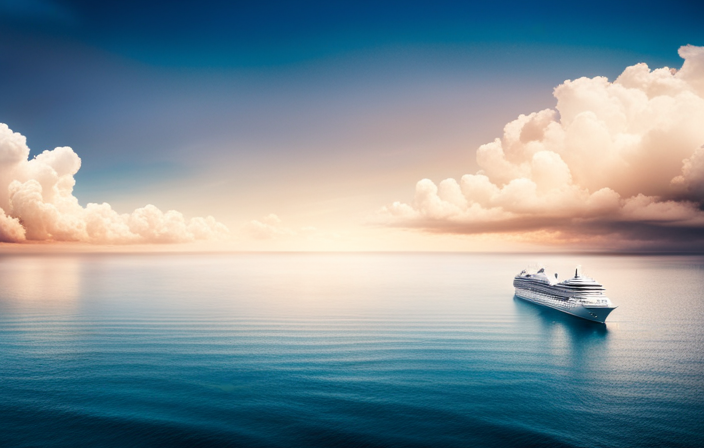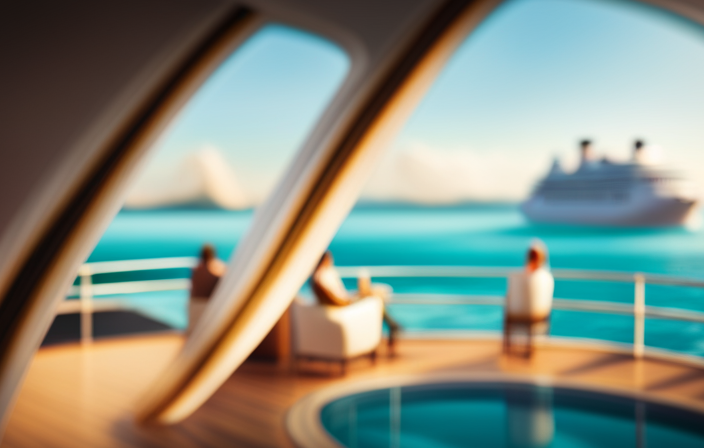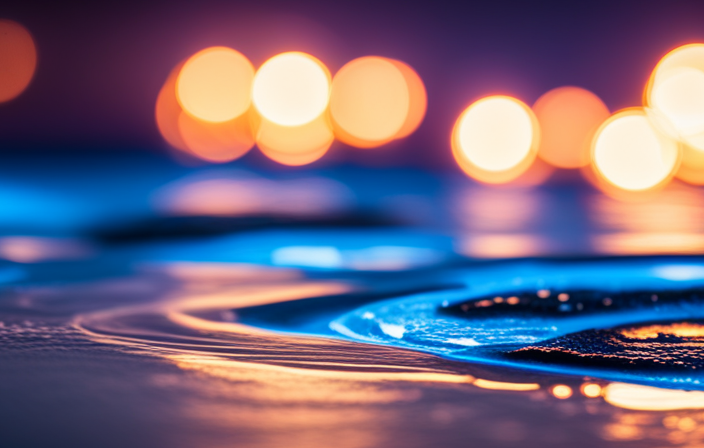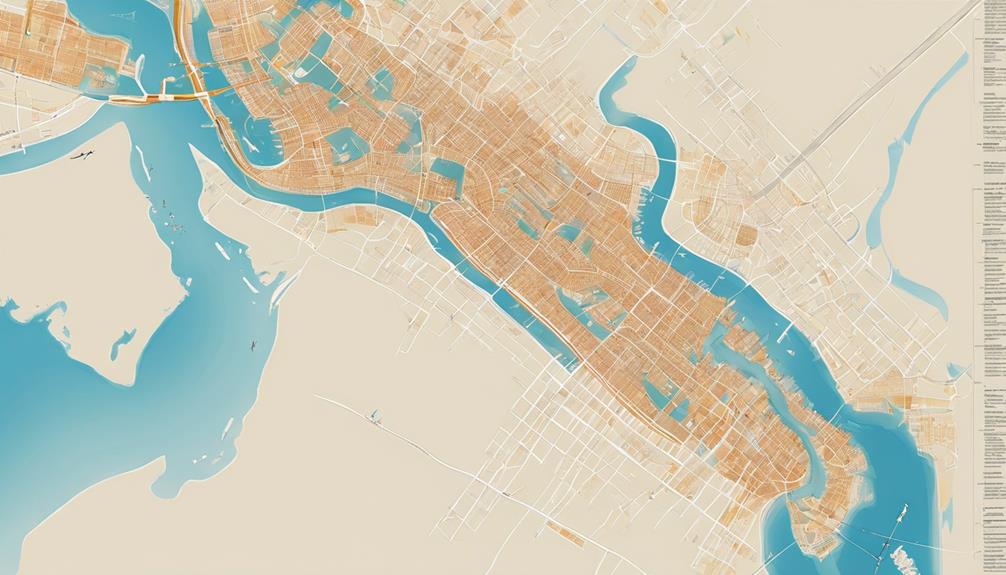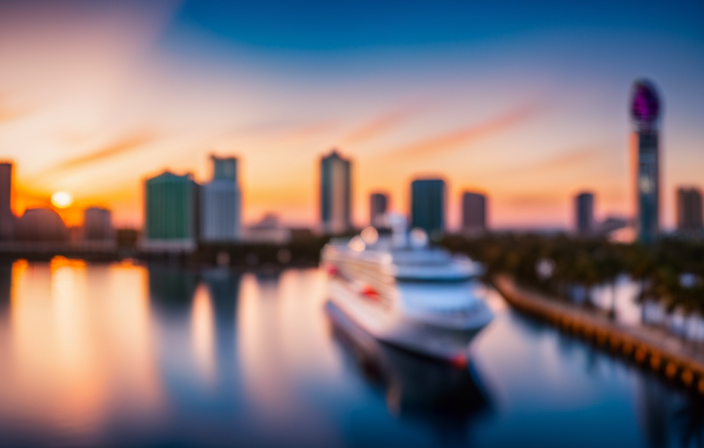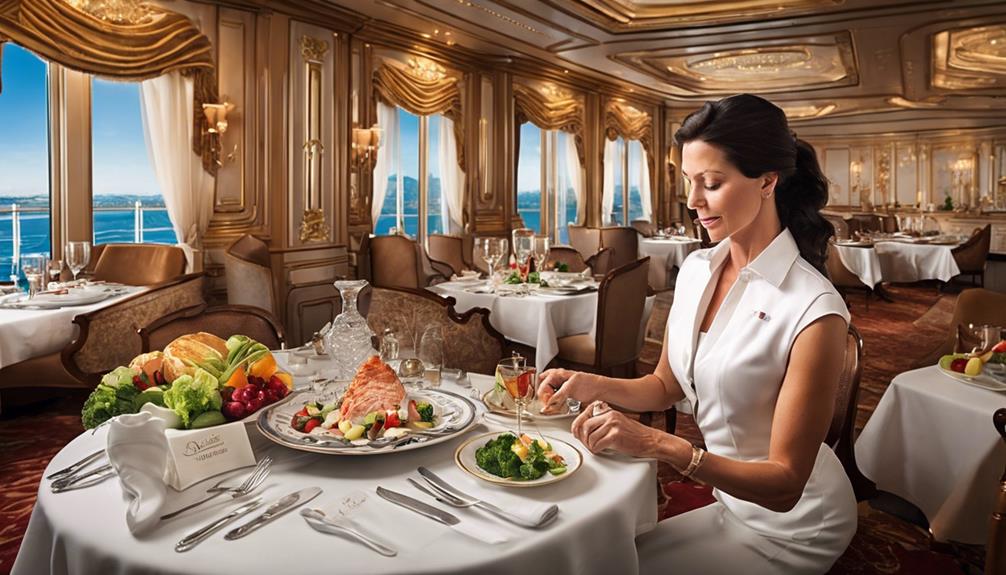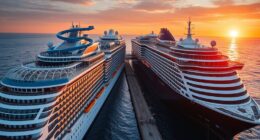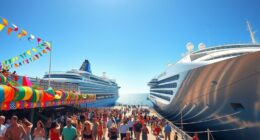Did you realize that those splendid cities on water, often referred to as cruise ships, come with their unique version of wings? Absolutely! Referred to as stabilizers, these extensions are vital in providing passengers with a smooth and steady journey across the sea.
With the ability to minimize the effects of rough seas and balance the ship’s weight distribution, these wings are more than just a design feature.
As a cruise enthusiast, I have always been fascinated by the intricate details of ship design, and the inclusion of stabilizers is no exception. In this article, we will delve into the function and importance of cruise ship stabilizers, exploring how they enhance passenger comfort and safety, reduce the ship’s environmental impact, and even shape the future of cruise ship design.
So, buckle up and prepare to embark on a technical journey to uncover the secrets behind why cruise ships have wings.
Key Takeaways
- Stabilizers on cruise ships counteract rolling motion caused by waves, maintaining balance and stability.
- Stabilizers enhance passenger comfort and safety by providing a smoother ride, minimizing noise and vibrations, and preventing accidents and injuries.
- Wings on cruise ships improve aerodynamics and reduce drag, leading to improved fuel efficiency.
- Cruise ships with stabilizers and wings contribute to sustainable and eco-friendly design, minimizing environmental impact and reducing emissions.
Understanding the Function of Stabilizers
Have you ever wondered why cruise ships have those cool-looking wings on the side? Let’s dive into the function of those stabilizers and how they help keep the ship steady in rough waters.
Cruise ships are equipped with stabilizers to enhance their stability and maneuverability. These stabilizers are designed to counteract the rolling motion caused by waves and maintain the ship’s balance. By extending horizontally from the ship’s hull, they create a hydrodynamic force that helps to reduce the ship’s rolling motion.
The effectiveness of the stabilizers is determined by their size, shape, and positioning on the ship. Larger and more advanced stabilizers can provide better stability, minimizing passenger discomfort and ensuring a smoother sailing experience.
Moreover, these stabilizers also have an impact on the ship’s maneuverability, allowing it to make precise turns and navigate through narrow passages. With stabilizers in place, cruise ships can navigate through rough waters with ease, ensuring smooth sailing and stability throughout the journey.
Ensuring Smooth Sailing and Stability
To ensure your voyage is as smooth as a gentle breeze, designers outfit these majestic vessels with specialized structures. One crucial element in achieving smooth sailing and stability is the presence of stabilizers.
These are wing-like structures that extend from the sides of the ship, helping to counteract the rolling motion caused by waves. By adjusting the angle of the stabilizers, the ship’s stability can be maintained even in rough seas, providing a more comfortable experience for passengers.
Additionally, these stabilizers play a vital role in the maintenance and repairs of the ship. They help to reduce the stress and strain on the hull, preventing excessive wear and tear. This ensures that the ship remains in optimal condition, minimizing the need for costly repairs and maximizing the overall passenger experience.
Transitioning into the next section, these stabilizers also contribute to enhancing passenger comfort and safety.
Enhancing Passenger Comfort and Safety
Get ready to experience a journey like no other, where your comfort and safety are prioritized at every turn. On cruise ships, enhancing passenger comfort and safety is of utmost importance. Every aspect of the ship’s design is meticulously planned to ensure passenger well-being.
Safety measures include the installation of state-of-the-art stabilizers, which greatly reduce the ship’s rolling motion, providing a smoother ride for passengers. These stabilizers work by adjusting their wings, or fins, to counteract the forces of the waves and keep the ship steady.
Additionally, advanced technologies are employed to minimize noise and vibrations, creating a peaceful and serene environment for passengers to relax in. These measures not only enhance passenger comfort but also contribute to their safety, as they help prevent accidents and injuries.
As we move forward into the next section about minimizing the effects of rough seas, let’s explore how these measures further enhance your cruise experience.
Minimizing the Effects of Rough Seas
Prepare yourself for a journey like no other, where you’ll be amazed at how the ship’s innovative stabilizers effortlessly counteract the forces of rough seas, providing you with a smooth and serene cruise experience. To understand how this works, let’s delve into the fascinating world of wave dynamics.
-
Wave Interference: The stabilizers are strategically designed to minimize the interference between the ship and the waves, reducing the rocking motion that passengers may feel.
-
Active Control System: These wings utilize advanced technologies, such as active control systems, which continuously analyze wave patterns and adjust the stabilizers’ position and angle accordingly.
-
Wildlife Protection: Cruise ships are mindful of the impact their stabilizers may have on marine life. By carefully engineering the wings, they minimize the disturbance to wildlife, ensuring a responsible and sustainable cruising experience.
-
Hydrodynamics: The shape and placement of the wings are precisely calculated to optimize hydrodynamic efficiency, allowing the ship to navigate through rough seas while maintaining stability.
As we explore further, let’s now delve into the crucial aspect of balancing the ship’s weight distribution.
Balancing the Ship’s Weight Distribution
Let’s now dive into how cruise ships ensure a smooth and stable voyage by carefully balancing the distribution of weight on board. Weight distribution management plays a crucial role in maintaining the ship’s stability and maneuverability.
To achieve this, cruise ships are designed with a complex ballast system that allows for the movement of water within the ship’s hull. By adjusting the water levels in various compartments, the ship’s weight distribution can be controlled, compensating for changes in cargo, passenger loads, and sea conditions.
This careful management of weight distribution minimizes the impact of rough seas on the ship’s stability and reduces the risk of capsizing. Additionally, it enhances the ship’s maneuverability, allowing for precise navigation in different conditions.
By optimizing weight distribution, cruise ships can ensure a safe and comfortable journey for passengers while maximizing efficiency in terms of fuel consumption and overall performance.
Transitioning into the next section about improving fuel efficiency, this weight distribution management plays a significant role in achieving optimal fuel economy.
Improving Fuel Efficiency
To maximize the cruising range and minimize fuel consumption, cruise ships continuously implement strategies to improve their fuel efficiency. Improving aerodynamics and optimizing propulsion systems are two key areas that cruise ships focus on to achieve this goal.
The addition of wings or fins to cruise ships is one way to improve aerodynamics. These wings are designed to reduce drag by redirecting airflow around the ship, which helps to increase fuel efficiency.
Furthermore, cruise ships are equipped with advanced propulsion systems that are constantly being optimized to reduce fuel consumption. These systems utilize technologies such as advanced propellers, energy-saving engines, and efficient power management systems.
By continuously improving aerodynamics and propulsion systems, cruise ships are able to operate more efficiently, reducing their environmental impact and ensuring a sustainable future for the industry.
Transitioning into the subsequent section about ‘reducing the ship’s environmental impact’, cruise ships are also implementing measures to minimize waste and carbon emissions.
Reducing the Ship’s Environmental Impact
One effective method of reducing the environmental impact of cruise ships is through the implementation of waste and carbon emission reduction measures. To achieve this, sustainable cruise ship design is crucial.
Reducing emissions is a top priority in the industry, and cruise ships are now equipped with advanced technologies to achieve this goal. These technologies include the use of cleaner fuels, such as liquefied natural gas (LNG), which produces lower carbon emissions compared to traditional fuels. Additionally, ships are designed with energy-efficient systems that minimize energy consumption and waste production. This includes the use of LED lighting, advanced wastewater treatment systems, and optimized hull designs to reduce drag.
By implementing these measures, cruise ships can significantly reduce their environmental impact and contribute to a more sustainable future for the industry.
Moving forward to the subsequent section about different types of cruise ship stabilizers, it is important to consider the role they play in enhancing the stability and maneuverability of these vessels.
Different Types of Cruise Ship Stabilizers
Cruise ships are equipped with different types of stabilizers, each designed to enhance stability and reduce the rolling motion. These stabilizers can be made from various materials such as steel, aluminum, or composite materials. The choice of material depends on factors such as weight, strength, and corrosion resistance.
One of the most advantageous types of stabilizers is the retractable stabilizer. These stabilizers can be extended or retracted as needed, allowing for improved maneuverability and reduced drag when cruising at higher speeds. By incorporating retractable stabilizers, cruise ships can optimize their performance and ensure a smoother sailing experience for passengers.
Moving forward, let’s delve into the evolution of stabilizer technology and explore how it has revolutionized the cruise ship industry.
The Evolution of Stabilizer Technology
As stabilizer technology evolved, cruise ships underwent a transformative journey, shedding their wobbly nature and emerging as graceful dancers on the sea. The evolution of cruise ship stabilizers has been driven by advancements in technology and a desire to enhance passenger comfort and safety.
Early stabilizers were simple fins mounted on the ship’s hull, providing limited stability in rough seas. However, with time, engineers developed more sophisticated designs, such as retractable fin stabilizers and active control systems.
These advancements allowed cruise ships to better counteract the rolling motion caused by waves, providing a smoother and more enjoyable experience for passengers. Furthermore, modern stabilizers are equipped with advanced sensors and computer-controlled actuators, allowing for real-time adjustments to maintain stability.
This constant evolution in stabilizer technology has paved the way for further innovations in cruise ship design and stability, ensuring a future of even smoother voyages on the high seas.
The Future of Cruise Ship Design and Stability
Get ready to experience a whole new level of exhilaration as the future of cruise ship design and stability takes you on a breathtaking journey through the high seas. Innovations in cruise ship propulsion systems have revolutionized the way these massive vessels navigate the water.
Advanced materials have played a crucial role in improving the overall design and stability of cruise ships. Lightweight and durable materials, such as carbon fiber composites, enable the construction of sleeker and more efficient hulls. These materials also contribute to reducing fuel consumption and emissions, making cruise ships more environmentally friendly.
Moreover, the use of advanced materials allows for the integration of cutting-edge technologies, such as sensors and monitoring systems, which enhance the ship’s stability and safety.
As we embark on this exciting future, cruise ship design and stability will continue to evolve, promising even more thrilling and secure voyages for all passengers.
Frequently Asked Questions
How much fuel does a cruise ship typically consume on a single voyage?
On a single voyage, a cruise ship typically consumes a considerable amount of fuel, impacting its fuel efficiency and emissions. The precise amount varies depending on factors such as ship size, speed, and itinerary.
What are the environmental benefits of using stabilizers on cruise ships?
Using stabilizers on cruise ships has several environmental benefits. They improve fuel efficiency by reducing the ship’s roll, which decreases drag and improves overall performance. This leads to lower fuel consumption and a reduced environmental impact.
How do stabilizers help in reducing motion sickness for passengers?
Stabilizer technology on cruise ships helps reduce motion sickness for passengers. By extending out from the ship’s hull, stabilizers counteract the ship’s motion, minimizing side-to-side swaying and reducing the likelihood of seasickness.
Are stabilizers only necessary for larger cruise ships or are they also used on smaller vessels?
Stabilizers are necessary for both larger cruise ships and smaller vessels. They improve fuel efficiency by reducing drag and wave resistance, and minimize the impact on marine life by reducing the ship’s rolling motion in rough seas.
How do cruise ships navigate through rough weather conditions and maintain stability?
To navigate through rough weather conditions and maintain ship stability, cruise ships utilize a combination of advanced navigation systems, such as radar and GPS, as well as stabilizers and ballast tanks that help counteract the effects of waves and wind.
Conclusion
In conclusion, cruise ships have wings, also known as stabilizers, for several important reasons.
Firstly, these wings are necessary to ensure smooth sailing and enhance passenger comfort and safety. By reducing the ship’s rolling motion, stabilizers help to minimize the discomfort and potential seasickness that passengers may experience. This allows for a more enjoyable and relaxing cruise experience.
Secondly, the wings help to minimize the effects of rough seas. They work by counteracting the forces of waves and wind, helping to keep the ship steady and reducing the amount of rocking and swaying. This is particularly important in areas with unpredictable weather or rough sea conditions, as it helps to maintain stability and prevent accidents or injuries.
Furthermore, the wings play a crucial role in balancing weight distribution on the ship. As cruise ships are large and carry a significant amount of weight, it is important to distribute this weight evenly to maintain stability. The wings help to achieve this balance by counteracting any imbalances caused by uneven loading or shifting of cargo and passengers.
Lastly, cruise ship wings also contribute to reducing the ship’s environmental impact. By improving stability and reducing the ship’s rolling motion, fuel consumption is minimized. This results in lower emissions and a more eco-friendly operation.
It is interesting to note that modern cruise ships can have stabilizers that extend up to 50 feet in length. This impressive size allows for an even higher level of stability, even in the most challenging conditions. As cruise ship design continues to evolve, the importance of these wings in ensuring a smooth and safe sailing experience remains paramount.

